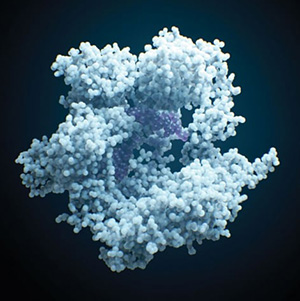Shirley Tilghman, Ph.D.: In the 19th century there was virtually nothing known about how characters or traits are passed from one generation to the next. Mendel was really the discoverer of the process that we now know as genetics. So I’ve been practicing genetics really for 30 years, but what is most beautiful about the story of Mendel is how he went about making those discoveries.
Gregor Mendel went to university to study mathematics. He then joined an abbey and began to become very interested in the question of how do traits get passed from one generation to the next. Mendel’s original idea was to use mice but he was forbidden to do this by the Abbott who felt that it was inappropriate for a monk to be studying what appeared to be sexual behavior between animals. Mendel then turned around and studied the sex life of peas.
They had what we now realize are purebred strains strains where no matter how many times you breed that strain to itself, you get the same plant back. And for Mendel this was incredibly important. But the second reason, is that pea plants are self-fertilizing. The pollen, which is the equivalent of the sperm and the ovule which is the equivalent of the egg are basically contained within the head of the flower. And so the only way you get the pollen inside is it’s either self fertilized or artificially fertilized by the scientist like Mendel. But it was critically important to his being able to know with every single plant who the original parents were of the cross.
What had happened in breeding experiments that had been done prior to Mendel, is too many things were varying at the same time. And that made it virtually impossible to interpret the results of the breeding experiments that were done. I think Mendel realized that he had to make things really simple. The common view at the time was that if you take plants that have two different characters, what you will get in the hybrid is sort of a blended average of the two characteristics. So if you had a tall plant and a short plant you’d get an intermediate size plant. That is not what Mendel observed.
He observed instead, that all of the plants in the hybrid cross were actually tall. And that told him something very important, which is that the tall character prevailed and the short character wherever that came from had disappeared completely. And so the question that Mendel might’ve asked at that point is whether the character that determines shortness in a plant had completely disappeared.

So he did the next really critical experiment which is he allowed those tall plants to self fertilize themselves. And he asked, “what do the seeds look like from the progeny of that cross?” And the answer was three of the progeny are tall and one of the progeny is short. So in that original tall plant in the first generation the short character had not been destroyed. It had not completely disappeared into the ozone. It had been dominated by the character tall.
And in fact, Mendel used that word, he said, “tall is dominant over short.” And the word he used to describe short is recessive. And what’s really remarkable is to this day we use these terms to describe the behavior of genes in crosses, which is amazing to me.
So the first group of plants that he did this with didn’t produce exactly the ratio of three to one. In fact I think the ratio was something in the neighborhood of 2.84:1. It’s a probability just as it is with tossing a coin, but the more one conducts the coin toss, and just like the more one does the experiments that Mendel conducted, the closer you will come to the ratio, the correct ratio.
So he then repeated this exact same experiment using different traits. But when he got to that second generation and asked what had happened to those differences they all approached a ratio of three to one. And it was through the ratio that told him something very important about the fact that traits come as discrete units. He didn’t know they were called genes. We didn’t know that for another 40 or 50 years, but, in fact, that’s what he was looking at.
I am sure there was an aha moment, a Eureka moment for Mendel. I don’t know whether it happened at 5,000 plants or 10,000 plants or 20,000 plants. But at some moment he must have looked at these numbers and said to himself, “this is really and truly approaching three to one. How can I now go back and understand what that ratio is telling me about characters and how they get passed from one generation to the next?”
Once Mendel had completed this monumental study, the next big question for him was, “well, what would happen if actually I had two traits varying in my cross instead of just one trait, do they always go together? Do they flow through generations together? Or can they actually be independently inherited from one another?”
So he took a tall plant that has pink flowers and a short plant that has white flowers. And he made the first generation hybrid. And even at this point, Mendel himself I suspect predicted what he would see in the first generation, which is the plants would be tall and they would have pink flowers, because he’d already shown those were the dominant characters. But now the key became what happens in the next generation.
So he self fertilized these plants and then planted the seeds that resulted. He found that nine of them were the original parental phenotype of tall and pink. Three of them were the hybrid combination of tall and white, and three were the combination of short and pink. And one was the original parental short and white. A nine to three to three to one ratio. And what that demonstrated to him is that tall and pink and white and short do not travel together inevitably. But in fact are behaving as though they are utterly independent of one another in these crosses. To Mendel this was a very important Second Law of Inheritance that he articulated for us.
I think Mendel really was a genius. He laid out the scientific method in such a methodical and rigorous way that I don’t think had ever been done before particularly in this field. That was true genius. And then the other was his ability to interpret his results. I don’t think it was obvious. And yet he got it exactly right. And we wouldn’t change a thing in his paper even today.
Now this was the days before the internet and days before social media and Twitter. Had Twitter existed in the 19th century, everyone would have known about Mendel’s experiments within a day. But instead it was published and promptly forgotten. So he was only rediscovered, essentially as the giant that he clearly is, well after his death.
In reading his paper, what I came to appreciate is that all of the rules that I have learned in the 20th century about how to go about designing a good experiment, how to conduct the experiment, how to interpret the results and then how to write them really clearly so audiences can appreciate what I’ve done we’re all on display by Gregor Mendel in the 19th century. It is perhaps one of the finest examples I know of a perfect experiment.
Elliot Kirschner (Executive Producer, Science Communication Lab): Executive Producer Sarah Goodwin (Executive Director, Science Communication Lab): Executive Producer
Nona Griffin: Producer and Editor
Chris George: Animations
Derek Reich: Cinematography
Eric Kornblum: Camera













